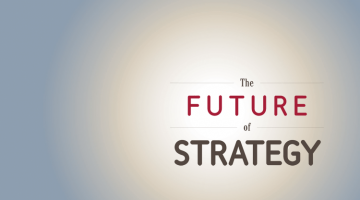Many of us have started the New Year with intentions to do a number of things differently that will in some way make us better or healthier. Most often, these are things that we know are right but that require effort and discipline to stick to. What if we also made New Year’s resolutions for how we do strategy? What would they be? In “The Future of Strategy,” a book I co-authored, we identified three resolutions for 2015 that we could use to make strategy better—three resolutions that, when combined, will actually be easy to adhere to.
Draw future inspiration directly into the formulation process
Most companies face an overload of important issues requiring urgent attention. This makes it tempting, and a seemingly good use of our time, to pay close attention to our “points of departure” and competitive urgencies in strategy efforts. However, this tends to shorten our strategic horizons. In a recent strategy study by A.T. Kearney, more than two-thirds of survey respondents indicated that their effective strategic cycles were now two years or less and shrinking. “But hey,” we tell ourselves, “we simply have to deal with this now. Maybe we will do some scenario planning to soothe our conscience.”
This makes for a good New Year’s resolution: We should draw the future much more directly into our strategy formulation efforts. Granted, this is a little bit more complicated and will require some effort, but it will substantially lengthen our strategic horizons and will provide crucial overall prioritization to sort out our present urgencies and hygiene.
Make strategy more organizationally inclusive
Strategy requires considerable effort and often come on top of serving customers and running our day-to-day business. There is simply no time to include more people, and especially more opinions, in the process. It is far more efficient to stick to fact-based analyses and a small group of decision makers for strategy formulation.
In doing so however, we know we sell ourselves short. Keeping strategy secret from competitors makes sense, but keeping our own organizations in the dark will seriously frustrate strategy deployment. We also deny ourselves access to the organizations’ firsthand experience in dealing with customers, facing competitors, running our processes, and bringing our brands and propositions to life—in short, a resource too valuable to leave out of the strategy formulation efforts.
This makes for a good second resolution: Involve much larger parts of our organizations in strategy formulation. This gives us better strategic insights, gives our organizations a crucial heads-up on deployment (dare we talk about ownership?), and makes our organizations much more future-embracing. In the same strategy study mentioned before, 74% of survey respondents believed inclusion would lead to more innovative strategies and 60% believed strategies would become more practical and implementable. Truth to be told, the skeptics of whether we can stick to our resolutions will not be surprised that more than two-thirds of the respondents also believed inclusion would make the strategy process more complex.
Make strategy more ongoing and life-cycle focused
We operate in a fast-paced world and, for most companies, the competitive issues and urgencies are piling up rather than abating. It is not surprising therefore, that our strategic plans become more all-encompassing—we need everything from customer delight, innovation of products, services, and business models, and operational excellence … and we need it all yesterday.
Deep down, we know this won’t all fit into a single make-everything-right strategic plan. Competitive advantage has simply become too transient for that—we need to react and anticipate in much shorter cycles in much more granular ways. A good third resolution is, therefore, that we promise ourselves to work on making strategy much more of a continuously guiding force instead of a single perfect plan.
A straightforward way for doing this is to see strategy not as a single (multi-year) plan but as a portfolio of competitive opportunities that is maintained on an ongoing basis. When certain opportunities have run their course, new ones stand ready to take over. At the same time, such a portfolio can provide the pragmatic and actionable link between the company’s overall strategic game plan and the strategic initiatives on the ground.
Overcoming the resolution skepticism
New Year’s resolutions do not have a good reputation. Too many diets and exercise plans get slowly absorbed back into old habits that refuse to die. So what is stopping these New Year’s resolutions for strategy from being absorbed into our frenzied day-to-day activities and traditional ways of going about Strategy?
Turns out we can enhance our chances of sticking to our resolutions by being ambitious and pursuing all three resolutions together. By themselves, the resolutions bring substantial benefits but come with downsides that require discipline and determination to overcome. The three resolutions reinforce each other, however, so considering them as a combination makes it easier to stick with them and reap their benefits.
Good future inspiration, for example, is ideal to help engage the organization in strategy formulation, much better than actions such as benchmarks and market segment analyses. In return, the firsthand knowledge of the organization can be instrumental in translating a complex set of strategic drivers into actionable opportunities for competitive advantage. Similarly, a portfolio approach to competitive opportunities is much better geared toward capturing the output of organizationally inclusive efforts and to serve as ongoing guidance for making the results happen. As an added bonus, it will also help provide guidance to sort out the many day-to-day activities and urgencies.
In the end, the best strategy is, therefore, to be ambitious and have New Year’s resolutions.








